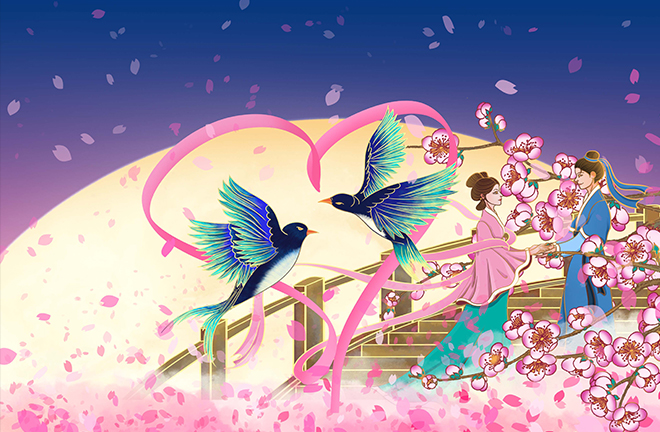Folk literature: aesthetic form in everyday life

The myth of “the Cowherd and the Weaver Girl” is a romantic Chinese folktale. Photo: TUCHONG
Folk literature, much like authored literature, is generally considered as an art form that uses language as its medium. In reality, folk literature possesses rich and diverse content, and reexamining it in the original context of everyday life is an inevitable path for its contemporary development.
Characteristics of folk literature
Literary theory often overlooks folk literature. Reception theory, reader-response criticism, and hermeneutic approaches, while emphasizing the central role of the literary audience, are focused on readers of written texts, leaving the audience of folk literature outside their purview. Works on the history of ancient and modern Chinese literature have touched on folk literature, but only superficially.
In the view of Mr. Zhong Jingwen, known as the “father of Chinese folklore studies,” China, being an ancient agricultural nation, has a type of literature that is more broadly created and disseminated beyond highbrow and popular literature—this is peasant literature, oral literature. All three layers of literature are valuable cultural assets of the Chinese nation.
Folk literature does not solely refer to folk textual records. Authentic folk literature exists within life itself, with many aspects that are difficult to describe in words. Furthermore, recorded texts can never fully replicate the performative nature of folk literature. Each performance by a folk artist is a creative and spontaneous act, and even when the same performer presents the same piece, no two performances are exactly alike.
Aestheticization of life world
The creation and dissemination of folk literature is deeply intertwined with various aspects of daily life, making it far more than a mere aesthetic process. The boundaries between literature and non-literature, artistic activities and non-artistic activities, as well as aesthetic and non-aesthetic experiences are extremely blurred in folk life. Since ancient times, the performance of folk literature has been closely integrated with people’s daily life, production, and various rituals, primarily serving practical purposes. Folk literature shifts the sublime, spiritual, idealistic, and abstract life images down to the earthly plane, the mundane, and the corporeal.
Before the 1990s, the study of folk literature in China was focused on folk literary text, with little attention paid to folk literary forms passed on through oral tradition in everyday life. Folk literary scholars tended to equate literature with text, believing that only in textual form could folk literature gain legitimacy, thereby justifying the existence of the discipline of folk literature studies. This understanding clearly echoed the literary perspectives and research paradigms of authored literature. However, in reality, text and the context of performance are inherently intertwined. When detached from the context of performance, text may be misinterpreted.
Folk literature is also an emotional expression of a nation’s history, religion, beliefs, ethics, and folklore. It narrates the evolving spiritual and material life of the local people. The understanding of the practical significance or value of folk literature was previously confined to the literary domain. In fact, only by placing folk literature within the broader context of real life can its relevance be fully grasped.
Modern development of folk literature
If folk literature is merely viewed as text meant for reading, while ignoring the actual circumstances and vivid process of its performance, it risks being reduced to fragmented words, structures, plot units, characters, and motifs. The comprehensive reexamination of the application of textual criticism to folk literature emerged with the introduction of performance theory, whose main contribution lies not in research methods but in research perspectives. Scholarly discussions have since revolved around the process and actions involved in folk literature performance, as well as the relationship between the performance text and the performance environment.
Currently in China, pioneering studies of folk literature concentrate on folk literary text in the state of being performed and emphasize the integration of text with context. However, this approach still places text (what is being performed) at the center. Text resources full of potential can be explored if a broader concept of “text” is adopted and entertaining or aesthetic folk literary life is regarded as complete text.
Scholars can creatively interpret and construct the living text of performance from different angles in their fieldwork, employing methods from disciplines such as history, religious studies, anthropology, and sociology to transcend the traditional paradigm of literary studies. In this way, folk literature can shed the burdens of tradition and continue to advance with a future-oriented academic stance.
Wan Jianzhong is a professor from the School of Chinese Language and Literature at Beijing Normal University.
Edited by WANG YOURAN
